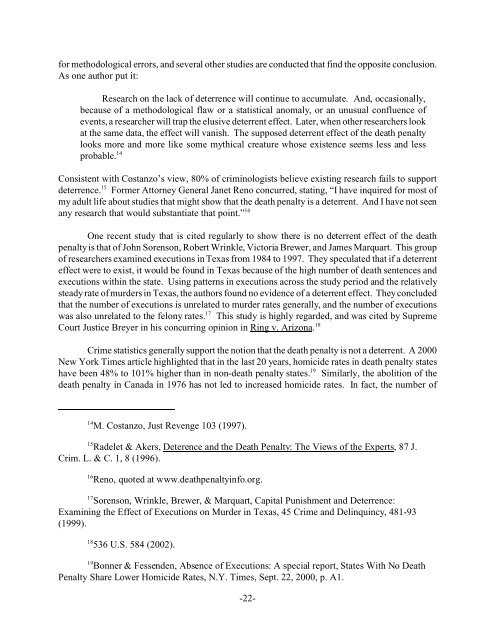report of the kansas judicial council death penalty advisory
report of the kansas judicial council death penalty advisory
report of the kansas judicial council death penalty advisory
Create successful ePaper yourself
Turn your PDF publications into a flip-book with our unique Google optimized e-Paper software.
for methodological errors, and several o<strong>the</strong>r studies are conducted that find <strong>the</strong> opposite conclusion.<br />
As one author put it:<br />
Research on <strong>the</strong> lack <strong>of</strong> deterrence will continue to accumulate. And, occasionally,<br />
because <strong>of</strong> a methodological flaw or a statistical anomaly, or an unusual confluence <strong>of</strong><br />
events, a researcher will trap <strong>the</strong> elusive deterrent effect. Later, when o<strong>the</strong>r researchers look<br />
at <strong>the</strong> same data, <strong>the</strong> effect will vanish. The supposed deterrent effect <strong>of</strong> <strong>the</strong> <strong>death</strong> <strong>penalty</strong><br />
looks more and more like some mythical creature whose existence seems less and less<br />
probable. 14<br />
Consistent with Costanzo’s view, 80% <strong>of</strong> criminologists believe existing research fails to support<br />
deterrence. 15 Former Attorney General Janet Reno concurred, stating, “I have inquired for most <strong>of</strong><br />
my adult life about studies that might show that <strong>the</strong> <strong>death</strong> <strong>penalty</strong> is a deterrent. And I have not seen<br />
any research that would substantiate that point.” 16<br />
One recent study that is cited regularly to show <strong>the</strong>re is no deterrent effect <strong>of</strong> <strong>the</strong> <strong>death</strong><br />
<strong>penalty</strong> is that <strong>of</strong> John Sorenson, Robert Wrinkle, Victoria Brewer, and James Marquart. This group<br />
<strong>of</strong> researchers examined executions in Texas from 1984 to 1997. They speculated that if a deterrent<br />
effect were to exist, it would be found in Texas because <strong>of</strong> <strong>the</strong> high number <strong>of</strong> <strong>death</strong> sentences and<br />
executions within <strong>the</strong> state. Using patterns in executions across <strong>the</strong> study period and <strong>the</strong> relatively<br />
steady rate <strong>of</strong> murders in Texas, <strong>the</strong> authors found no evidence <strong>of</strong> a deterrent effect. They concluded<br />
that <strong>the</strong> number <strong>of</strong> executions is unrelated to murder rates generally, and <strong>the</strong> number <strong>of</strong> executions<br />
was also unrelated to <strong>the</strong> felony rates. 17 This study is highly regarded, and was cited by Supreme<br />
Court Justice Breyer in his concurring opinion in Ring v. Arizona. 18<br />
Crime statistics generally support <strong>the</strong> notion that <strong>the</strong> <strong>death</strong> <strong>penalty</strong> is not a deterrent. A 2000<br />
New York Times article highlighted that in <strong>the</strong> last 20 years, homicide rates in <strong>death</strong> <strong>penalty</strong> states<br />
have been 48% to 101% higher than in non-<strong>death</strong> <strong>penalty</strong> states. 19 Similarly, <strong>the</strong> abolition <strong>of</strong> <strong>the</strong><br />
<strong>death</strong> <strong>penalty</strong> in Canada in 1976 has not led to increased homicide rates. In fact, <strong>the</strong> number <strong>of</strong><br />
14<br />
M. Costanzo, Just Revenge 103 (1997).<br />
15<br />
Radelet & Akers, Deterence and <strong>the</strong> Death Penalty: The Views <strong>of</strong> <strong>the</strong> Experts, 87 J.<br />
Crim. L. & C. 1, 8 (1996).<br />
16<br />
Reno, quoted at www.<strong>death</strong><strong>penalty</strong>info.org.<br />
17<br />
Sorenson, Wrinkle, Brewer, & Marquart, Capital Punishment and Deterrence:<br />
Examining <strong>the</strong> Effect <strong>of</strong> Executions on Murder in Texas, 45 Crime and Delinquincy, 481-93<br />
(1999).<br />
18<br />
536 U.S. 584 (2002).<br />
19<br />
Bonner & Fessenden, Absence <strong>of</strong> Executions: A special <strong>report</strong>, States With No Death<br />
Penalty Share Lower Homicide Rates, N.Y. Times, Sept. 22, 2000, p. A1.<br />
-22-

















